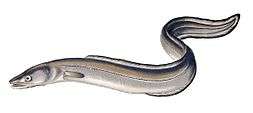Blind cave eel
| Blind cave eel | |
|---|---|
| Scientific classification | |
| Kingdom: | Animalia |
| Phylum: | Chordata |
| Class: | Actinopterygii |
| Order: | Synbranchiformes |
| Family: | Synbranchidae |
| Genus: | Ophisternon |
| Species: | O. candidum |
| Binomial name | |
| Ophisternon candidum (Mees, 1962) | |
The blind cave eel (Ophisternon candidum) is a species of fish in the Synbranchidae family. It is endemic to subterranean waters in the Cape Range, Australia. Like other cave adapted fish such as Milyeringa (the only other vertebrates restricted to subterranean waters in Australia), the blind cave eel is entirely blind and lacks pigmentation. It is listed as vulnerable under the Australian Environment Protection and Biodiversity Conservation Act 1999. Reaching a length of 40 cm (16 in), it is the longest known cavefish. In its history of being listed by the IUCN since 1988, it has not been well known hence the Data Deficient status.
Synbranchidae
The Synbranchidae family is largely found in tropical and subtropical regions. They are usually freshwater inhabitants, but have adapted to live in briny and estuary waters. The same species has also been found in swamp and marsh environments where they display amphibious and burrowing behaviours. Many of the species are capable of aerial respiration.[1]
Ophisternon is found in Australasia, Indo-Malaysia, West Africa and some islands of the Caribbean.
Diet
Due to their habitat, very little is known about the biology of this species. However, they have been identified as nocturnal feeders that feed opportunistically upon detritus, algae, and animals that fall into the water (e.g., insects).[2]
References
- ↑ Rosen & Green Wood (1976). "A fourth neotropical species of synbranchid eel and the phylogeny and systematics of synbranchiform fishes.". Bulletin of the American Museum of Natural History (157): 1–70.
- ↑ Humphreys & Freinberg (1995). "Food of the blind cave fishes of northwestern Australia". Records of Western Australian Museum. 17: 29–33.
Sources
- Wager, R. 1996. Ophisternon candidum. 2006 IUCN Red List of Threatened Species. Downloaded 4 August 2007.
- Department of the Environment, Water, Heritage and the Arts (2008). Ophisternon candidum in Species Profile and Threats Database, Department of the Environment, Water, Heritage and the Arts, Canberra. Ophisternon candidum — Blind Cave Eel Downloaded 3 January 2008.

